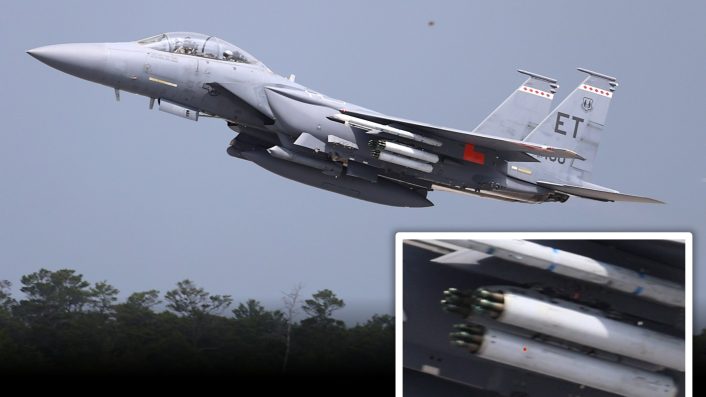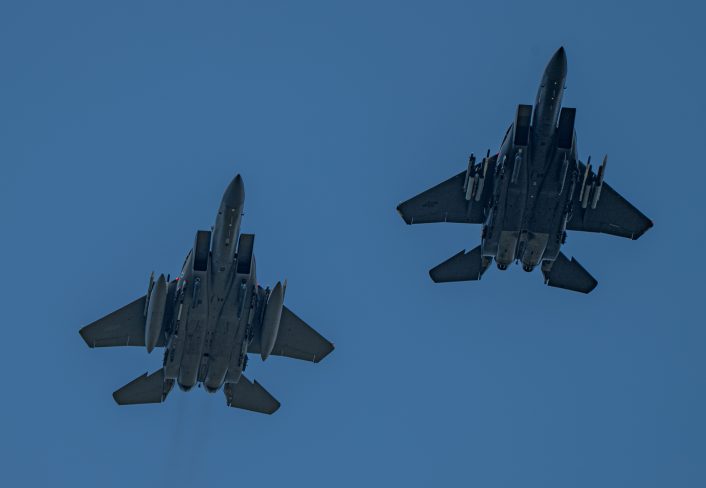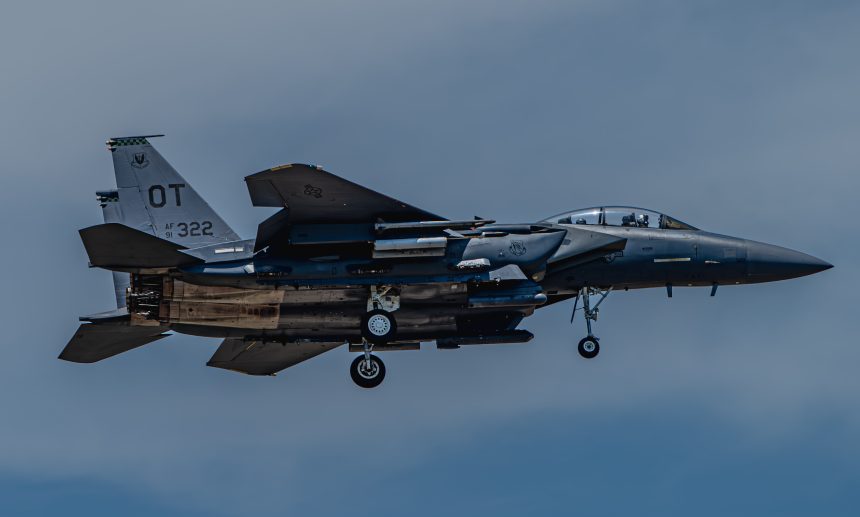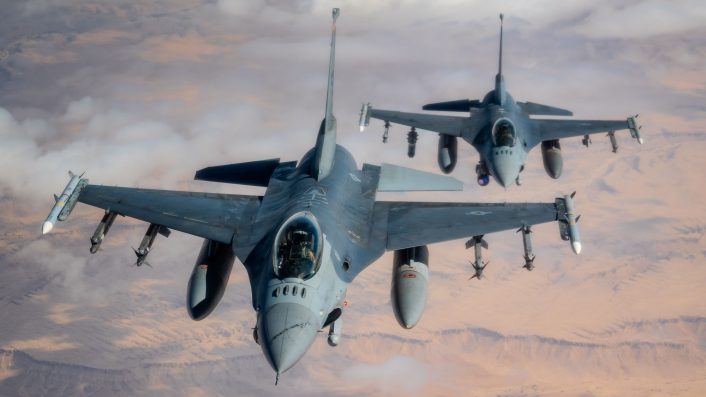At least two Strike Eagles have been employed in the tests, equipped with four or six LAU-131 pods which would allow to carry up to 42 rockets during drone-hunting missions.
Some images recently surfaced online show U.S. Air Force (USAF) F-15E Strike Eagles based at Eglin Air Force Base, Florida, flying with a variety of configurations featuring LAU-131 rocket launchers. This represents a new addition to the already impressive arsenal of weapons that can be employed by the F-15E, and likely a consequence of the lessons learned while countering drones in the Middle East.
The first of these images were first published by The Merge on it social media channels, and showed an F-15E from the 96th Test Wing’s 40th Flight Test Squadron carrying three LAU-131A/As on the left wing, mounted on a TER (Triple Ejector Rack). The LAU-131A/A, an extended version of the standard LAU-131A, can carry 7 rockets, the pods on the aircraft were fully loaded with AGR-20 APKWS II (Advanced Precision Kill Weapon System II) laser guided rockets.
That’s a beast-mode-for-drones loadout. pic.twitter.com/YdNRHgkwzP
— The Merge 🇺🇲 (@MergeNewsletter) May 22, 2025
If the jet was also carrying the same number of launchers on the right wing, it would mean that it carried up to 42 rockets. The jet was also loaded with CATM-120s and a flight data instrumentation pod, as well as an AN/AAQ-13 LANTIRN navigation pod and an AN/ASQ-33 Sniper ATP (Advanced Targeting Pod).
As this first photo was uncredited and no other details were available, The War Zone was able to obtain confirmation from the Air Force. “I can confirm the pic was taken here at Eglin AFB,” said Gabriel Myers, a spokesperson for the 96th Test Wing. “The Eglin AFB test community through strong partnerships have aggressively conducted integrated tests of the Advanced Precision Kill Weapon System. By working at speed to ensure advanced capabilities have the intended effects, we increase warfighter readiness and lethality to meet the global demands of the joint force.”
It is unclear when the F-15E would be cleared to operationally field the APKWS II, but Myers also told The War Zone that he was unable to “speak to specific timelines [for the test work], but we can say it was done rapidly.” The mention of the work being done rapidly might further hint that this testing is in support of an Urgent Operational Need (UON) originated from the drone hunting missions which saw multiple F-15Es involved in the Middle East.

Images of a second F-15E, this time assigned to the 53rd Wing’s 422nd Test and Evaluation Squadron, also based in Eglin, were then taken on May 23, 2025,, by the author’s friend @warthawg_images while spotting at the base. The photos showed the F-15E carrying a nearly identical loadout, except that this F-15E carried two LAU-131s on each wing with the center ejector rack on the TER being empty.
As the photos of the F-15E were taken after a sortie and the LAU-131s were empty, it is unclear if it was carrying the APKWS II rockets or if they were expended during the test flight.
If the jet, which was on a sortie with an F-15EX from the same wing, had indeed carried APKWS IIs it could signal that the rocket is already close to entering service with the F-15E: the 53rd Wing is an OT&E (Operational Test & Evaluation) Wing and tests concepts that are closer to being fielded operationally in contrast to the ET (Experimental Test) 96th Test Wing, which focuses more on experimental loadouts. Another explanation could be that the quad-rocket launcher loadout was tested previously, and that the loadout with six LAU-131s is being tested by the 96th Test Wing as an option for carrying more rockets.

The APKWS II
The rockets loaded on the launchers were identified as APKWS II, a type that has recently been introduced into the air-to-air domain being used by USAF F-16s to shoot down Houthi drones around the Red Sea. The APKWS II, which was first tested as an air-to-air weapon back in 2019, provides a cheap solution to engage both air and ground targets. In the counter drone role, the F-16s often operated in pairs with one jet ‘painting’ the target with a laser from the Sniper ATP while the other made an attack run with the rockets.
The recent introduction of the APKWS II as a counter-drone weapon for the F-16, which carried just one or two rocket launchers, effectively tripled its engagement opportunity when compared to previous loadouts featuring just six air-to-air missiles, while drastically reducing the cost per kill: an AIM-9X costs about $450,000 and an AIM-120 more than $1 million, while a single APKWS II rocket is estimated to have a price point of around $30,000. However, its air-to-air target portfolio is limited to steady targets such as drones or cruise missiles; it is not able to maneuver as much as other specialized air-to-air weapons like the AIM-9 or AIM-120.
It is not entirely surprising that the work to integrate the APKWS II onto the F-15E has begun; the F-15E was involved in defending Israel against Iran’s drone attacks back in April 2024, and the lack of a substantial amount of air-to-air missiles was the limiting factor in being able to quell the attacks. An F-15E armed to the brim with air-to-air rockets would allow for a substantially longer and efficient counter-drone sortie.
In the U.S., the following aircraft have already been integrated with the laser guided rockets: U.S. Marine Corps AV-8Bs, F/A-18C/Ds, AH-1Z and UH-1Ys; USAF F-16C/Ds and A-10Cs; U.S. Navy MH-60R/Ss; and U.S. Army AH-64D/Es.

The AGR-20 APKWS II is a conversion of the Hydra 70 unguided rockets which adds a laser guidance kit to the baseline weapon, turning it into a precision-guided munition (PGM). By adding a guidance section between the 10-pound high-explosive warhead at the front of the rocket and the Mk66 Mod 4 rocket motor at the rear, the U.S. Air Force has therefore been able to obtain low-cost smart munitions, that can be used instead of more costly options.
The guidance section of the APKWS includes four foldable wings with wing-mounted laser seeker collection optics, called the Distributed Aperture Semi-Active Laser Seeker (DASALS), with a wide field of view which enable to engage both moving and stationary targets. The weapon system underwent the Fixed Wing, Air Launched, Counter-Unmanned Aircraft Systems Ordnance (FALCO) upgrade program meant to improve the counter-UAS capabilities.
The AGR-20 FALCO is an upgrade over the APKWS II, which includes software upgrades to increase the lethality of the weapon in air-to-air engagements against UAS. This variant is currently fielded in the CENTCOM AOR and is being used with a high probability of kill.
FALCO was a response to an emerging operational need and, after being seamlessly rolled out, enabled a significant improvement in the U.S. Air Force’s counter-UAS capabilities.
BAE Systems has unveiled a new infrared seeker for the APKWS II, in addition to the existing laser guidance, making this a dual-mode weapon. The new IR seeker builds on the new FALCO capabilities, improving even more the C-UAS capabilities of the service.










